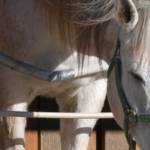Vitamin E Deficient Myopathy

Vitamin E deficient myopathy is a newly recognized cause of muscle loss and weakness. Horses affected with vitamin E deficient myopathy have many of the same clinical signs as horses with equine motor neuron disease (EMND), and both conditions are related to vitamin E deficiency.
Mitochondrial disease has been recognized in humans and horses as an occasional cause of muscle disease. Mitochondria are important in cells because they serve as the energy-producing organelle, and mitochondrial disease affects energy metabolism. It is believed that vitamin E deficiency leads to a reversible oxidative stress affecting the mitochondria with resulting weakness.
Special staining of sacrocaudalis (tail head) muscle biopsies from horses with vitamin E deficient myopathy revealed abnormal staining of the mitochondria in muscle cells without the changes seen in EMND. Muscle biopsies from the same muscle are used to diagnose EMND, but the special mitochondrial stains are not used because the muscle is fixed in formalin, which interferes with the special mitochondrial stain. It is not known if vitamin E deficient myopathy is a unique disease or an early, reversible stage of EMND.
Diagnosis of vitamin E deficient myopathy involves measuring vitamin E concentrations in serum and muscle, and special staining and microscopic examination of sacrocaudalis muscle biopsies. Vitamin E concentration in muscle biopsies from affected horses will be low, but serum vitamin E concentration may be low or normal.
Horses with vitamin E deficient myopathy should be treated with water-soluble, natural vitamin E supplements such as Nano-E. Affected horses recover after several weeks of supplementation and regain normal muscle mass and strength.








